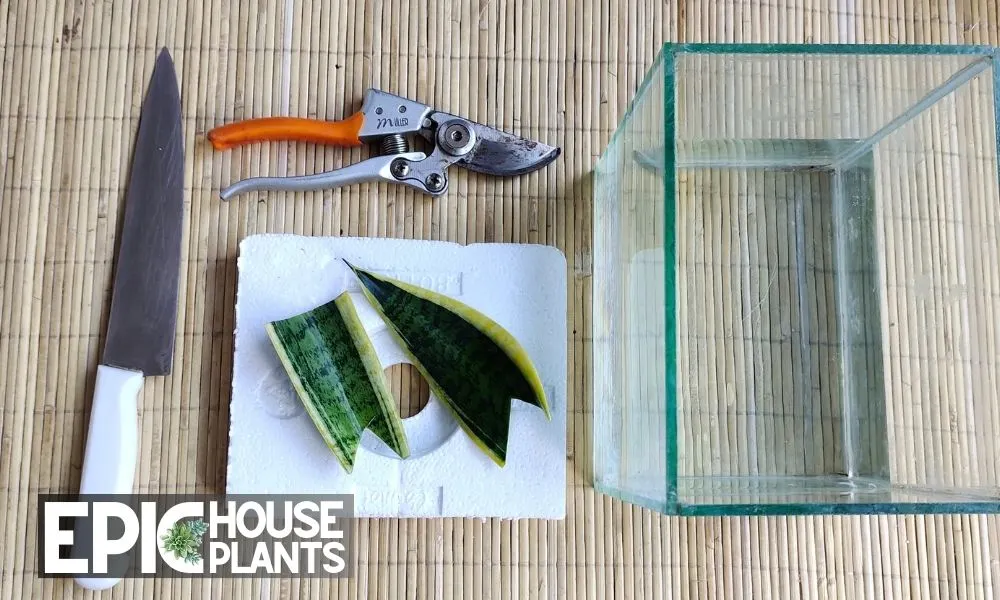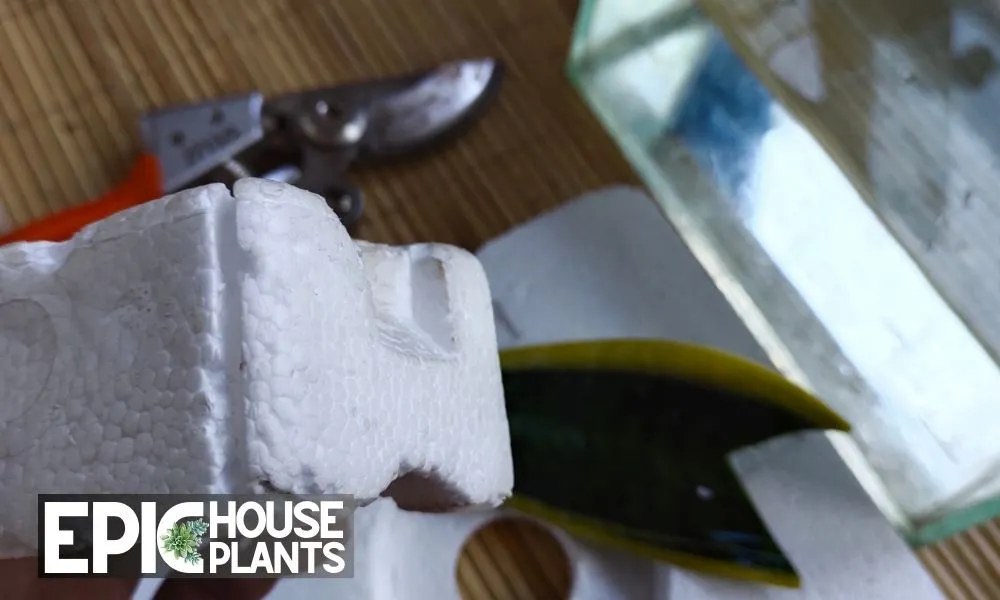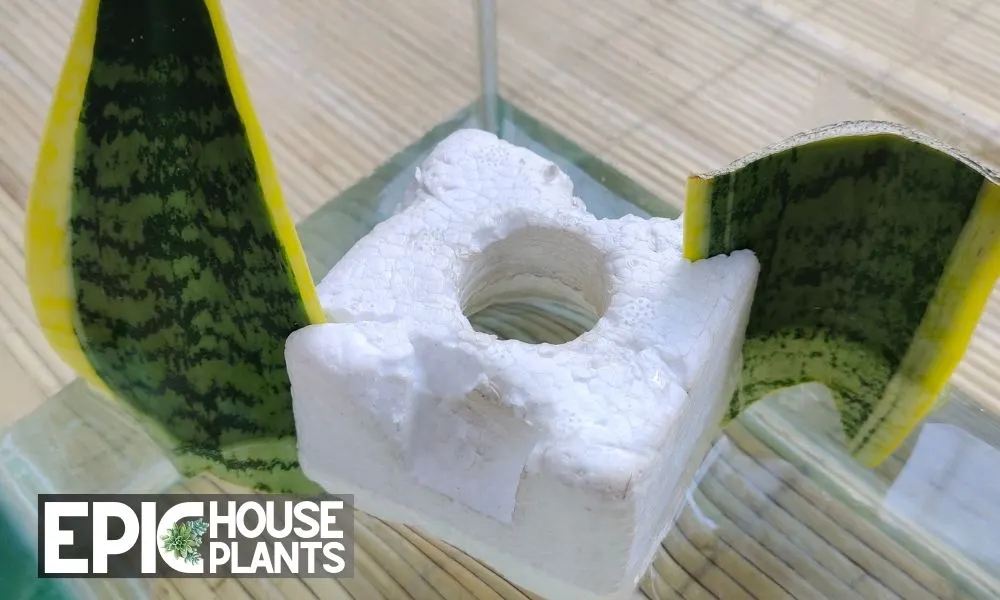Snake plants, also known as Sansevieria, are one of the most versatile and hardy houseplants to care for. One unique aspect of snake plants is their ability to propagate, or create new plants, through a process that involves water.
However, you can enhance this snake plant water propagation process by using two simple household items: styrofoam, cork or tape.
But why, you might ask, should we even consider floating systems in our propagation routine?
Why the Floating System Matters?
Minimizes Root Disturbance:
Floating systems allow the cuttings to stay stationary, reducing unnecessary disturbance to the tender, emerging roots. This encourages healthy growth and faster establishment.
Ensures Adequate Water Contact:
By keeping the cut end of your plant in constant contact with water, the floating system guarantees optimum water absorption, a crucial factor in the propagation process.
Prevents Submersion:
If left unchecked, cuttings might sink, leading to the entire plant being submerged underwater, which can cause rot. The floating system keeps the top part of the plant free from excess moisture, preventing this issue.
Let’s now delve into the methods to achieve this floating system using styrofoam and tape.
Also Read: Repotting Snake Plant Like a Pro: A Comprehensive Guide
Styrofoam Method

Step 1: Preparation
Begin by cutting a small piece of styrofoam, enough to hold your plant cutting above water. Make sure the styrofoam piece is large enough to float but small enough to fit into your container.
Step 2: Making the Hole

Using a sharp tool, create a small hole in the center of the styrofoam piece. The hole should be wide enough to snugly fit your plant cutting.
Step 3: Insertion
Insert the snake plant cutting into the hole you’ve made in the styrofoam. The cutting end should go through the styrofoam, leaving the leafy part on top.
Step 4: Placement

Place the styrofoam with the plant cutting in a container filled with water. The styrofoam should float, and the cut end of the snake plant should be submerged in water.
Step 5: Maintenance
Change the water regularly, every 5-7 days, to prevent stagnation and possible rot.
Tape Method
Step 1: Preparation
Get your container filled with water, plant cutting, and a piece of tape.
Step 2: Taping
Place your snake plant cutting on the rim of the container, ensuring the cut end dips into the water. Hold the cutting in place and run the tape across the top of the container, securing the plant in position.
Step 3: Adjustment
Adjust the plant cutting if necessary to make sure the end remains in contact with the water but doesn’t submerge completely.
Step 4: Maintenance
Like the Styrofoam method, it’s essential to change the water every 5-7 days to ensure healthy propagation.
Cork Method
Another household item you could consider using for water propagation is a cork. It’s a non-toxic, buoyant material that can support your plant cutting. Here’s a step-by-step guide on how to use it.
Step 1: Preparation
Gather your snake plant cutting, a clean container with water, and a cork.
Step 2: Making The Hole
Using a screwdriver or another sharp tool, bore a small hole into the cork. The hole should be wide enough to snugly hold the plant cutting.
Step 3: Insertion
Insert the cut end of the snake plant into the hole you’ve made in the cork, ensuring the leafy part of the plant is on top.
Step 4: Placement
Put the cork with the plant cutting into the container filled with water. Make sure that the cork floats and only the cut end of the plant is submerged.
Step 5: Maintenance
Remember to change the water every 5-7 days to keep it fresh and prevent the possibility of rotting.
FAQs
Q: Can I use any other materials besides styrofoam or tape? A: Yes, the goal is to keep the cutting stationary and ensure only the cut end is in contact with water. Any non-toxic, buoyant material can work.
Final Words
Plant propagation is not just about multiplying your indoor green family; it’s a journey of patience, love, and learning
By understanding the needs of your plant and adapting your methods, you’re not only ensuring the growth of a new plant, but also deepening your connection with nature.
Whether you use the traditional water propagation or opt for the Styrofoam, tape, cork, or plastic mesh methods, remember: each plant is unique, and so is its journey to growth.
Embrace the process, observe the changes, and soon, you’ll have a new, thriving snake plant ready to grace your space!
Author

Pudji Haryanto
Pudji Haryanto is a writer and urban farmer with a passion for cultivating plants. He has over 15 years of experience in agriculture and currently manages a 65,000 square foot rice-field and yard filled with various plants, including vegetables, spices, flowers, and garden plants.

Have you ever considered about adding a little bit
more than just your articles? I mean, what you say is important
and all.
But think about if you added some great pictures or
videos to give your posts more, “pop”! Your content is excellent but with images
and videos, this website could definitely be one of the greatest in its field.
Good blog!
Thank you for your feedback James!
I appreciate your suggestion to enhance the content on this website and your kind words about the content and your thoughtful suggestion. It’s always great to receive feedback that helps improve the overall user experience. 🙂